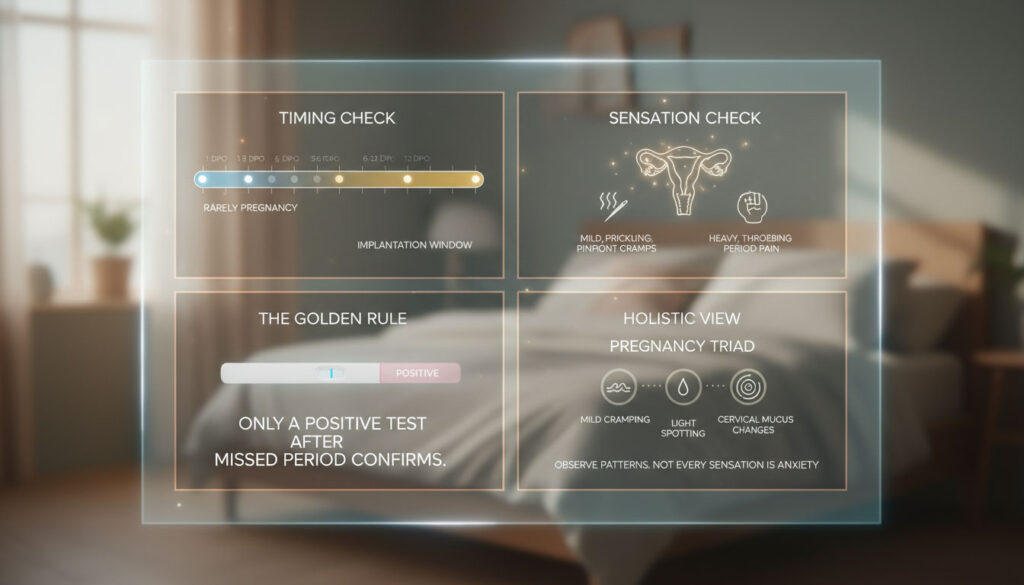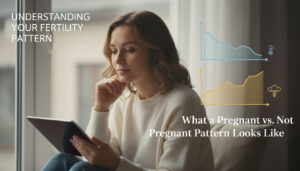For many women, the days following ovulation are filled with a unique blend of hope and hyper-vigilance. Every twinge in the lower abdomen, every slight shift in energy, and every subtle sensation becomes a subject of intense analysis. You pause and wonder if that pulling feeling on your left side is just digestion, or if it is the very first signal of a new life taking root. This period, often called the “Two Week Wait,” transforms your body into a puzzle where cramping after ovulation is the most confusing piece.
Table of Contents
This cramping can indeed be a sign of implantation, specifically known as implantation cramps. This phenomenon typically occurs 6 to 12 days past ovulation (DPO), marking the moment a fertilized egg burrows into the uterine lining. Unlike the heavy, rhythmic throb of menstruation, implantation pain is often described as a mild prickling, pulling, or tingling sensation.
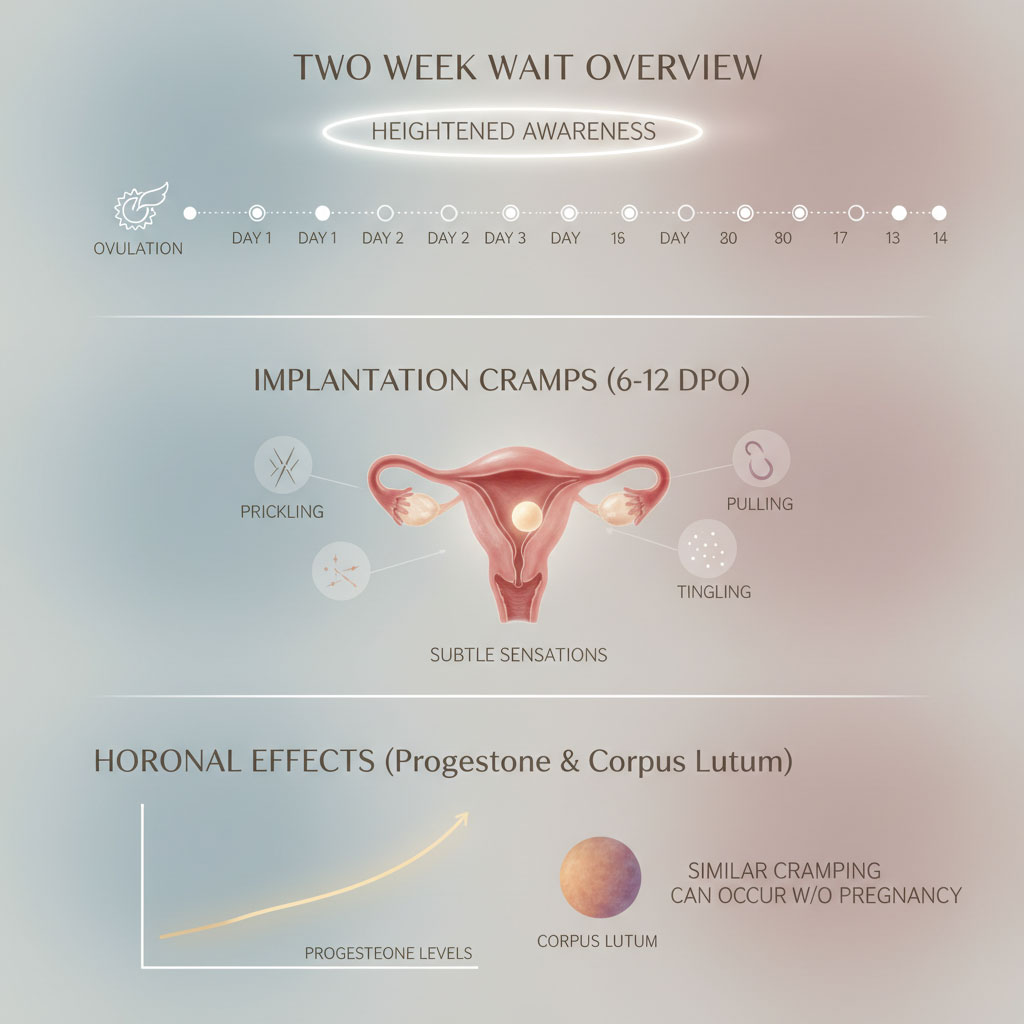
However, the biological reality is complex. Similar sensations can arise from the natural rise in progesterone produced by the corpus luteum, meaning that cramping alone is not a definitive proof of conception. To truly understand what your body is telling you, we must look deeper into the physiological shifts of early pregnancy.
The Biology of Post-Ovulation Cramping: What is Happening Inside?
To distinguish between a positive sign and a false alarm, it is essential to understand the invisible machinery operating within the reproductive system during the luteal phase. This phase is the time between ovulation and the start of your next period, and it is a hotbed of hormonal activity regardless of whether you are pregnant.
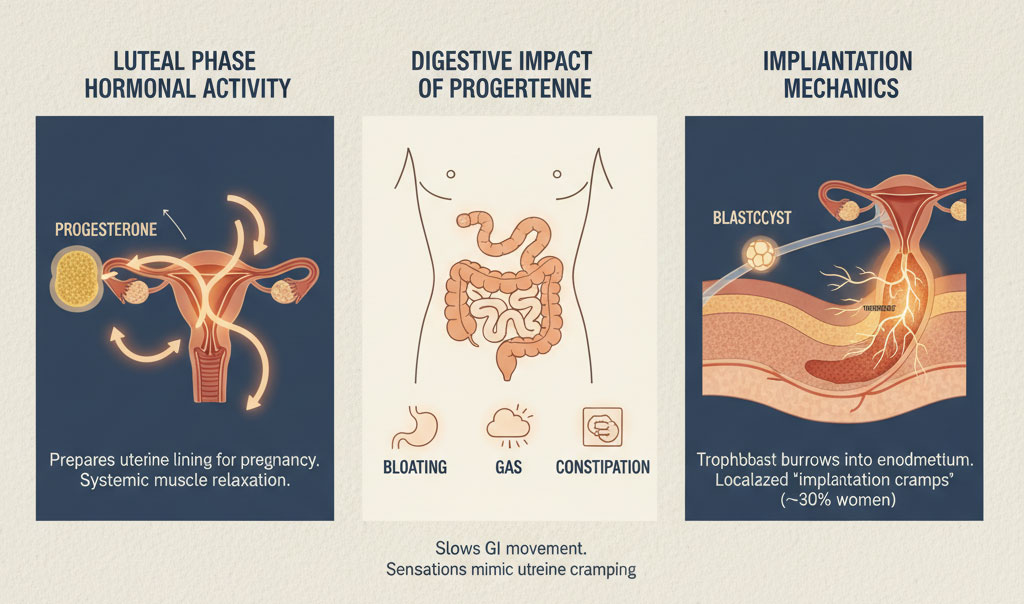
The Corpus Luteum and Progesterone Spikes
Once an egg is released during ovulation, the follicle that held it does not simply disappear. It undergoes a rapid transformation into a temporary endocrine gland known as the corpus luteum. This gland is the powerhouse of early pregnancy support. Its primary job is to secrete increasing amounts of progesterone, a hormone that prepares the endometrium (uterine lining) to receive an embryo.
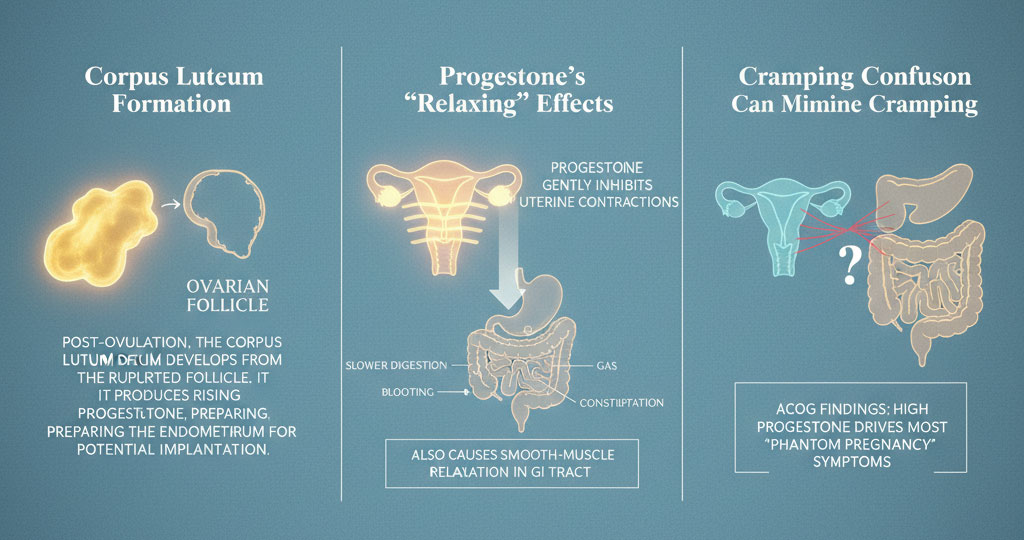
Progesterone is often called the “relaxing hormone” because it prevents the uterine muscles from contracting, which would otherwise expel a fertilized egg. However, this relaxing effect is systemic. It also relaxes the smooth muscles of the gastrointestinal tract. When the gut slows down, digestion becomes sluggish. This often leads to trapped gas, bloating, and constipation.
For many women, the pressure from trapped gas or a slower bowel feels remarkably similar to uterine cramping after ovulation. According to data from the American College of Obstetricians and Gynecologists (ACOG), high progesterone levels are responsible for the vast majority of “phantom pregnancy” symptoms in non-pregnant cycles. This biological overlap is why symptom spotting can be so deceptive.
The Mechanics of Implantation
If conception is successful, the journey is just beginning. The fertilized egg, now developing into a blastocyst, travels down the fallopian tube over the course of several days. Upon reaching the uterus, it must perform a complex biological maneuver called implantation. This is not merely a gentle landing; it is an invasive process where the blastocyst must breach the surface of the uterine wall.

The outer layer of the blastocyst, called the trophoblast, releases enzymes to dissolve a small depression in the endometrial lining. It then burrows into the nutrient-rich tissue to establish a connection with the mother’s blood supply. This microscopic excavation disrupts tiny blood vessels and irritates the local uterine tissue. For approximately 30% of women, this physical burrowing triggers a distinct sensation known as implantation cramps.
These cramps differ from menstrual cramps because they are highly localized. They are caused by a specific event at a specific site in the uterus, rather than the generalized, organ-wide shedding mechanism that causes period pain.
Differentiating the Pain: Ovulation vs. Implantation vs. Period
Understanding the nuance of pain is your best tool for interpretation. The sensation, timing, and location of cramping after ovulation can often reveal its source days before a pregnancy test can confirm it.
Timing is Everything: The DPO Timeline
Biologically, pregnancy symptoms cannot start until implantation occurs. Hormones like human chorionic gonadotropin (hCG) are not present in the bloodstream until the embryo connects with the uterine blood supply.
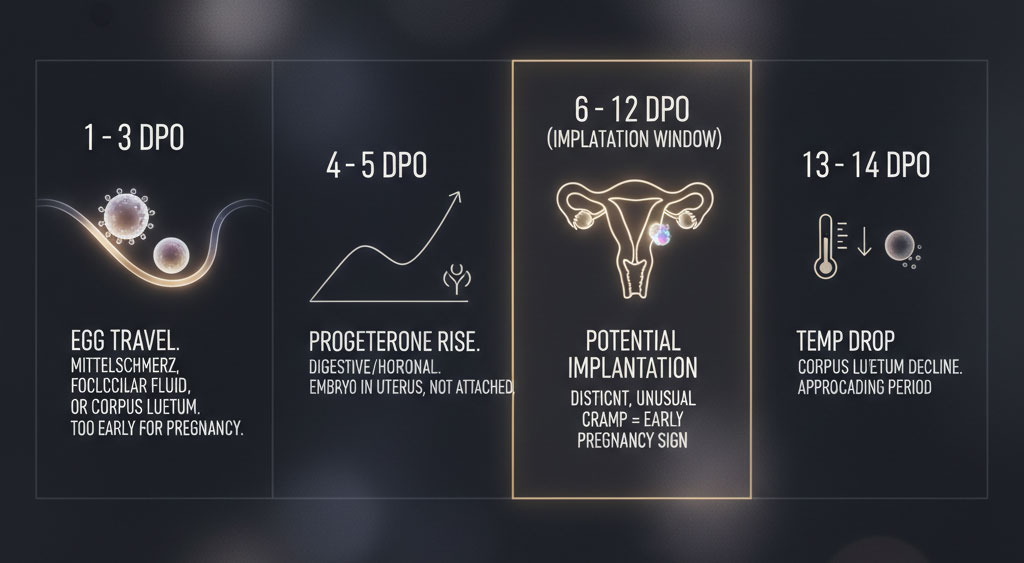
- 1–3 Days Past Ovulation (DPO): At this stage, the egg is still traveling through the fallopian tube. Cramping after ovulation occurring here is likely residual ovulation pain (Mittelschmerz), fluid irritation from the ruptured follicle, or the physical sensation of the corpus luteum forming. It is biologically too early for pregnancy symptoms.
- 4–5 DPO: Progesterone levels are climbing rapidly. Cramping experienced during this window is usually digestive or hormonal. The embryo has reached the uterus but has not yet attached.
- 6–12 DPO: This is the critical “Implantation Window.” If you feel a new, distinct cramp during this phase, specifically if it is unlike your usual pre-menstrual pattern, it aligns with the timeline for early pregnancy signs.
- 13–14 DPO: Cramping that begins here, especially if accompanied by a drop in basal body temperature, is often a sign that the corpus luteum is failing and menstruation is imminent.
Sensation Descriptors: The Language of Pain
Women who have confirmed pregnancies often look back and realize their cramps felt fundamentally different from their monthly cycle. While pain is subjective, the descriptors used often follow a pattern.

- Ovulation Pain: This is typically sharp, sudden, and strictly one-sided (lateralized to the ovary releasing the egg). It can switch sides month to month.
- Implantation Cramps: Often described as a light “tugging,” “prickling,” “vibrating,” or “needle-poke” sensation. It is rarely painful enough to require painkillers and is often fleeting.
- Period Cramps: These are characterized by a deep, heavy, throbbing ache that involves the entire lower pelvis and often radiates to the lower back and thighs. This pain is caused by prostaglandins triggering strong uterine contractions to shed the lining.
Detailed Comparison of Pelvic Pain Types
| Feature | Ovulation Pain (Mittelschmerz) | Implantation Cramps | Menstrual Cramps (Period) |
| Timing | Mid-cycle (Day 14 approx.) | 6–12 Days Post-Ovulation | 1–2 days before bleeding starts |
| Primary Cause | Rupture of follicle/egg release | Embryo attaching to uterine lining | Uterine contractions (Prostaglandins) |
| Sensation | Sharp, sudden, one-sided | Light pulling, pricking, or tingling | Dull, throbbing, heavy ache |
| Location | Left or right hip/ovary | Lower central abdomen or slightly off-center | Lower abdomen, radiating to thighs/back |
| Duration | Minutes to 24 hours | Intermittent (hours to 2 days max) | Constant for 2–5 days |
| Severity (1-10) | 4–7 (Sharp but brief) | 1–3 (Very mild, often ignored) | 5–9 (Can be debilitating) |
The “Pregnancy Triad”: Symptoms That Accompany Implantation Cramps
Cramping after ovulation rarely happens in isolation if it is a true sign of conception. The body is undergoing a systemic shift, and multiple systems respond simultaneously. To build a stronger case for pregnancy before testing, look for accompanying symptoms that form the “Pregnancy Triad.”
Implantation Bleeding
As the blastocyst implants, it may rupture tiny capillaries in the uterine wall. This can result in implantation bleeding, which is frequently misunderstood.
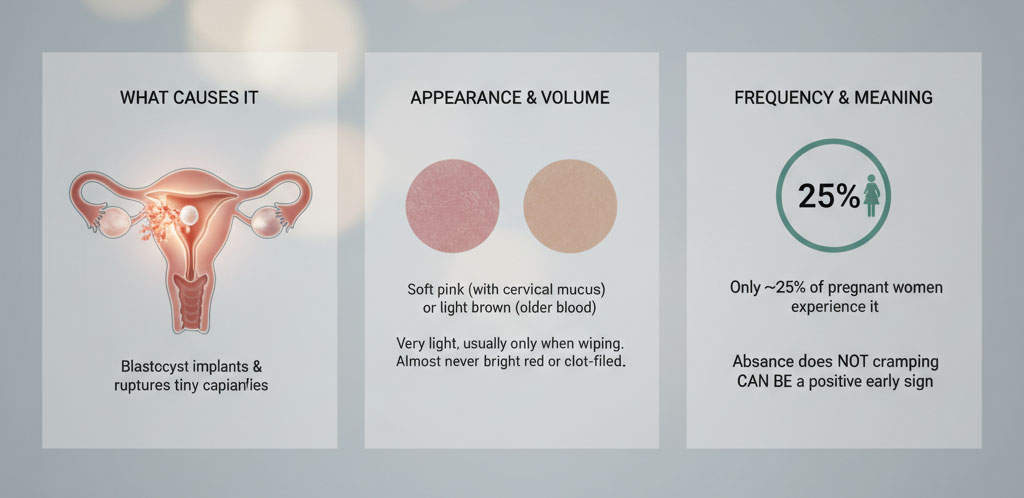
- Appearance: Unlike menstrual flow, this spotting is usually pink (indicating it is mixed with fertile cervical mucus) or brown (indicating it is older blood that took time to exit). It is almost never bright red with clots.
- Volume: It is typically extremely light spotting that is visible only when wiping. It rarely flows enough to require a tampon or fill a pad.
- Frequency: It is important to note that only about 25% of pregnant women experience this. The absence of bleeding does not mean you are not pregnant, but its presence alongside mild cramping is a strong positive indicator.
Basal Body Temperature (BBT) Shifts
For women who track their cycle using a basal thermometer, Basal Body Temperature (BBT) can offer one of the earliest physiological clues.
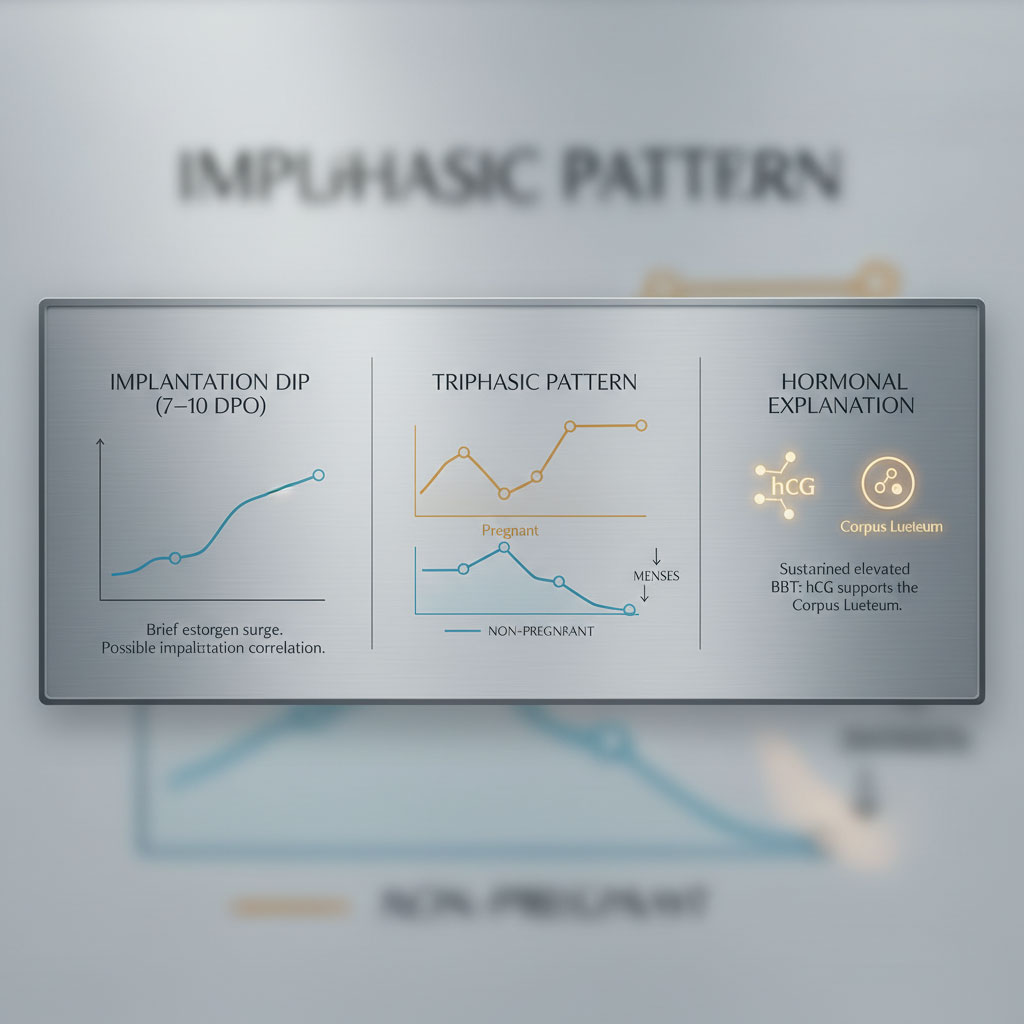
- The Implantation Dip: You may observe a distinct, one-day drop in temperature around 7–10 DPO. This is hypothesized to be a reaction to a secondary estrogen surge that accompanies implantation.
- The Triphasic Pattern: In a non-pregnant cycle, temperatures drop just before the period starts. In a pregnant cycle, the temperature may rise to a third, higher level after implantation and stay elevated. This “triphasic” chart indicates that the corpus luteum is being rescued and supported by rising Human Chorionic Gonadotropin (hCG) levels.
Cervical Mucus Changes

In a typical non-pregnant cycle, cervical mucus dries up shortly after ovulation due to the dominance of progesterone. You might feel “dry” or “sticky” for the remainder of the luteal phase. However, if conception occurs, estrogen levels remain higher than usual. This can cause a resurgence of cervical fluid known as “leukorrhea.”
If you notice an increase in creamy, milky white moisture alongside mild cramping after ovulation, rather than the usual pre-period dryness, it is a significant physiological sign.
Latest Industry Trends: Femtech and Cycle Tracking Insights
The way women interpret early pregnancy signs has shifted dramatically with the advent of “Femtech.” We now have access to data from millions of cycles, which helps us understand the reality of implantation cramps versus statistical noise.
How AI and Algorithms Predict Implantation
Modern fertility apps like Flo, Premom, and Clue utilize massive datasets and machine learning to predict fertile windows and potential implantation dates. These tools are incredibly useful for logging symptoms, but users should be cautious about over-reliance.
Most apps predict implantation based on a statistical average (usually set to 9 DPO). They do not have access to your real-time hormonal levels. If an app sends a notification saying you are “implanting” today, treat it as a calendar estimate, not a medical diagnosis. Real cramping after ovulation is the only physical verification your body can give you, and it may happen days before or after the app’s prediction.
New Research on Hormonal Sensitivity and Prostaglandins
Recent discussions in fertility medicine suggest that a woman’s individual sensitivity to prostaglandins may determine whether she feels implantation or not. The uterus releases a tiny, localized amount of prostaglandins at the implantation site to help the embryo invade the tissue and stimulate new blood vessel growth.
Women who typically experience painful periods (dysmenorrhea) usually have higher baseline prostaglandin levels or higher receptor sensitivity. These women may be more likely to perceive the subtle “micro-cramps” of implantation. Conversely, women who rarely have period pain might have a successful implantation without feeling a single twinge.
Symptom Cluster Comparison: PMS vs. Pregnancy
Distinguishing between Pre-Menstrual Syndrome (PMS) and early pregnancy is one of the most difficult challenges in the TWW because progesterone drives both.
| Symptom | Pre-Menstrual Syndrome (PMS) | Early Pregnancy Signs |
| Cramping Pattern | Intensifies as period approaches | Occurs early (6-10 DPO), then stops |
| Food Cravings | Sweets, salty, chocolate (General) | Aversions to smells, specific odd cravings |
| Breast Changes | General tenderness/swelling | Heaviness, darkening of areolas, visible veins |
| Energy Levels | Fatigue that resolves with period | Extreme exhaustion (Progesterone crash) |
| Mood | Irritability, sadness | Weepiness, emotional volatility |
| Nausea | Rare | Common (starts as “queasiness” or food aversion) |
Practical Strategies: What To Do When You Feel Cramps
Experiencing cramping after ovulation often incites a desire to rush to the pharmacy and purchase every test available. However, strategic timing is critical to avoid the emotional rollercoaster of false results.
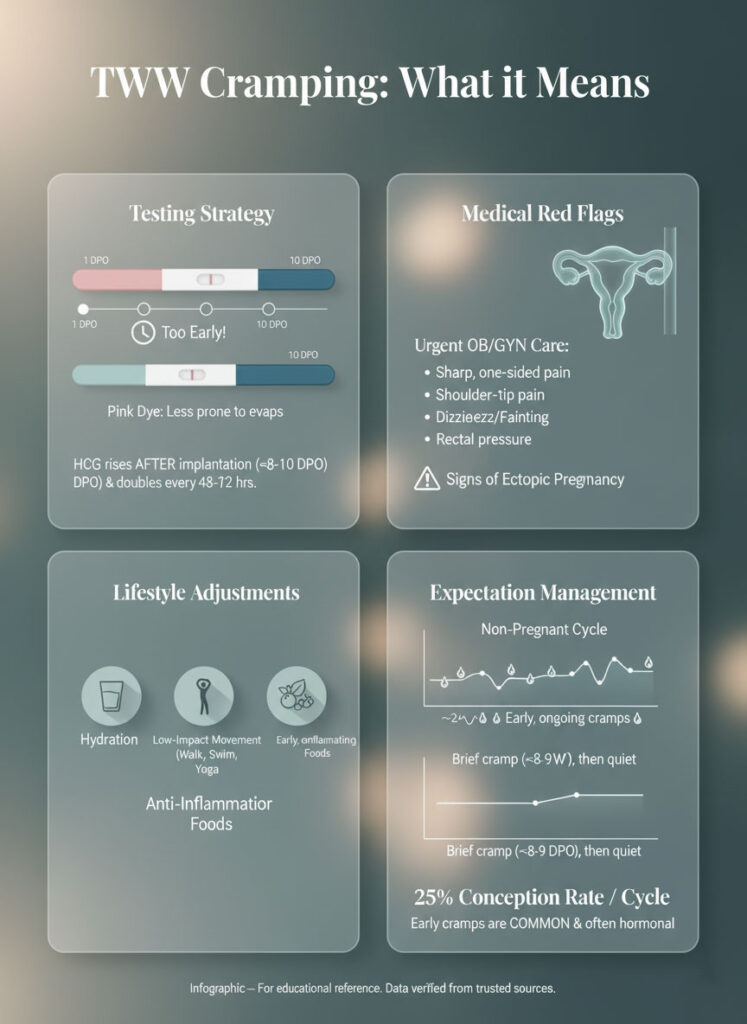
The “Wait and Watch” Protocol
If you feel cramps at 7 DPO, taking a pregnancy test immediately will almost certainly yield a negative result, even if you are pregnant. The hormone hCG, which triggers a positive result on a urine test, is not produced until after implantation is complete.
Once implantation starts, hCG levels begin at zero and typically double every 48 to 72 hours.
- Strategy: If you feel implantation cramps on a Tuesday, the earliest you should consider testing is Friday. Testing too early detects a baseline zero.
- Test Selection: Use a “Pink Dye” test (like First Response Early Result) for early testing. “Blue Dye” tests are notorious for evaporation lines that can look like faint positives, leading to unnecessary heartbreak.
Distinguishing Medical Emergencies
While most lower abdominal cramping is benign, certain pain patterns require immediate medical attention. The fallopian tubes are not designed to stretch. If an embryo implants there (Ectopic Pregnancy), it creates a medical emergency.
If you experience sharp, severe, stabbing pain on one side of the abdomen, specifically if it is accompanied by shoulder tip pain, dizziness, rectal pressure, or fainting, seek help immediately. These are classic signs of an ectopic pregnancy. This condition is life-threatening and requires immediate intervention by an OB/GYN.
Lifestyle Adjustments During the TWW
When you suspect early pregnancy symptoms like cramping, it is wise to modify your daily routine slightly to support potential implantation.
- Hydration: Dehydration can cause muscle spasms that mimic cramps. Drinking adequate water ensures optimal blood volume for the developing uterine lining.
- Movement: Switch from high-intensity interval training (HIIT) or heavy lifting to lower impact activities like walking, swimming, or yoga. This reduces physical stress on the body while progesterone levels are rising.
- Diet: Focus on anti-inflammatory foods. High sugar and processed foods can increase prostaglandin production, potentially exacerbating cramping.
Case Studies and Real Data: Managing Expectations
To manage the anxiety of the TWW, it is helpful to look at the hard data surrounding signs of pregnancy rather than relying solely on hope.
Statistical Probability
According to the American Society for Reproductive Medicine (ASRM), a healthy couple in their 20s has only about a 25% chance of conceiving in any given cycle. This number drops as age increases.
When users on forums report “I knew I was pregnant because I cramped,” it is often a case of confirmation bias. Thousands of women experience cramping after ovulation due to progesterone every month and turn out not to be pregnant, but these non-pregnant cycles are rarely written about in “success story” threads.
Anecdotal Evidence vs. Medical Reality
A composite analysis of user stories from community platforms like The Bump, Reddit’s TTC forums, and What To Expect reveals a common pattern that aligns with medical science.
- The Non-Pregnant Profile: Cramping often starts early (2–3 DPO), continues intermittently throughout the luteal phase, gets progressively worse closer to the expected period, and is often accompanied by typical PMS signs like acne and sugar cravings.
- The Pregnant Profile: There is often “radio silence” in the uterus until about 8 or 9 DPO. Then, a sudden, distinct “pinch,” “shock,” or light cramp occurs for a few hours. It stops abruptly. This is often followed by a temperature dip or spotting. A positive test appears 3 to 4 days later.
This distinction highlights a crucial takeaway: for implantation cramps, less is often more. Continuous, daily cramping is usually hormonal or digestive. A singular, distinct, and novel event is more likely to be implantation.
Summary & Key Takeaways
Deciphering cramping after ovulation requires patience, self-awareness, and a keen understanding of your body’s timeline. It is a practice of listening to whispers rather than shouts.

- Timing Check: Cramps occurring 1–5 DPO are rarely pregnancy-related; focus your attention on sensations occurring between 6–12 DPO.
- Sensation Check: True implantation cramps are mild, prickling, and localized. They do not feel like the heavy, throbbing ache of a pending period.
- The Golden Rule: Symptoms are only clues. The only definitive proof of pregnancy is a positive test taken after a missed period.
- Holistic View: Look for the “Pregnancy Triad” of cramping, spotting, and cervical mucus changes rather than focusing on pain alone.
Listen to your body, but do not let every twitch dictate your emotional state. Mild cramping after ovulation is a hopeful sign, but it is just one piece of the complex, miraculous puzzle of conception.
Frequently Asked Questions (FAQs)
Can cramping after ovulation be a sign of twins?
While some anecdotal evidence suggests that higher hormone levels with twins might cause more noticeable symptoms, there is currently no concrete scientific evidence that cramping after ovulation is more severe with twins. The mechanics of implantation—the burrowing of the blastocyst—are physically similar regardless of whether one or two embryos are attaching. However, higher hCG levels later in the pregnancy (weeks 4-6) may cause more intense nausea or fatigue.
Is it normal to have cramps 5 days after ovulation?
Yes, it is very normal, but it is likely not implantation. Cramping at 5 DPO is usually caused by rapidly rising progesterone levels affecting your digestion, causing gas and bloating. It can also be the corpus luteum cyst resolving or releasing fluid. It is typically too early for implantation cramps at this stage, as the egg usually has not yet reached the uterine wall.
Does the intensity of implantation cramps predict the gender?
No. The gender of the baby is determined by the chromosomal contribution of the sperm (X or Y) at the exact moment of fertilization. The intensity of implantation cramps is determined by your personal pain threshold, the exact location of attachment in the uterus, and your sensitivity to prostaglandins. There is no biological link between pain severity and the sex of the baby.
Can you feel conception the moment it happens?
Biologically, no. Fertilization happens on a microscopic level deep inside the fallopian tube. The cells involved are microscopic, and the fallopian tubes do not have the type of nerve endings that would allow you to feel cellular division. Any sensation felt immediately after sex or ovulation is likely related to the physical act itself, ovulation pain, or uterine spasms, not the moment of conception.
Why do I have cramps but a negative pregnancy test?
There are several reasons for this common scenario. First, you may have tested too early; if you feel implantation cramps, you must wait at least 3–4 days for hCG to rise to detectable levels. Second, the cramps could be due to PMS, digestive issues, or a urinary tract infection. Third, it could be a “chemical pregnancy,” which is a very early loss where implantation occurs (causing cramps) but the embryo stops developing before hCG gets high enough for a positive test.
Is white discharge with cramping a sign of pregnancy?
Yes, creamy white discharge (leukorrhea) accompanied by mild cramping can be a strong sign of the “Pregnancy Triad.” It indicates that estrogen and progesterone remain high, preventing the shedding of the uterine lining. In a non-pregnant cycle, discharge usually dries up before the period. The presence of this moisture is a positive indicator.
How soon after implantation cramps can I test?
Patience is key here. It is best to wait at least 48 to 72 hours after the cramping stops. The placenta needs this time to secrete levels of hCG that can trigger the dye on a home pregnancy test. Testing on the same day as the cramp will almost always result in a negative because the hormone has not yet entered your urine stream in sufficient quantities.
Do implantation cramps happen at night or during the day?
They can happen at any time of day or night. However, many women report noticing them more at night. This is likely because when you are lying still in bed, you are less distracted by work, movement, or daily activities, making the subtle lower abdominal cramping or tingling sensations much more apparent than they would be if you were walking around.
Can stress delay implantation or cause cramps?
Yes, indirectly. High levels of cortisol (the stress hormone) can delay ovulation, which pushes back the entire timeline of implantation. Furthermore, stress causes physical muscle tension and can significantly affect digestion. This tension and digestive upset can lead to abdominal cramping that is easily confused with cycle-related pain or implantation.
What is the difference between gas pain and implantation cramps?
This is the most common confusion. Gas pain often moves around the abdomen; you might feel it on the left, then the right. It is often sharp and is usually relieved by passing gas or changing physical positions. Implantation cramps are typically stationary, felt low in the center or slightly to one side of the pelvis, and are not relieved by bowel movements or shifting position.
Does taking progesterone supplements cause cramping?
Yes. If you are on progesterone support (common in IVF cycles or for those with luteal phase defects), cramping is a very common side effect of the medication itself. The high levels of progesterone slow the bowel and relax uterine muscles, leading to sensations that mimic both PMS and pregnancy. If you are taking supplements, symptom spotting becomes very difficult; you must rely on the blood test.
Should I stop exercising if I feel cramping after ovulation?
You do not need to stop completely, but listening to your body is essential. It is advisable to modify intensity. If you feel cramping after ovulation, switch to low-impact exercises like walking or swimming. High-impact jumping or heavy lifting can cause additional strain. If a workout increases the pain, stop immediately and rest. Movement is good for blood flow, but exhaustion is not.

